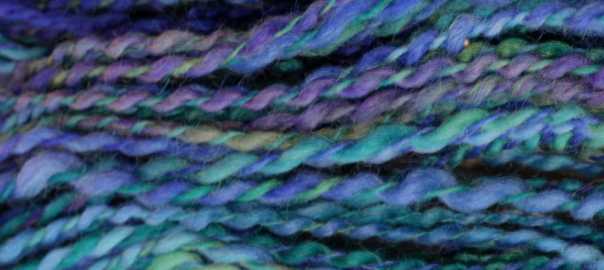A detailed account of how I turned this roving into this yarn

I apologize for not posting over the weekend. I was busy spinning (insert big grin right here). I’ll make it up to you all with this long and (hopefully) informative post on how I spun the Northern Lights Wool Top in color way Violets from Louet.
But first a few notes on the quality of this roving. I’ve spun with top from Louet before so I knew what I was getting; something good. Northern Lights roving comes in a strip that’s thinner than usual. It’s about one third the width of standard roving and so I’ve always called it “pencil” roving. It’s shipped not as a braid but loosely packed into an air-filled bag. What all that means is it comes to the spinner loose, not compacted, and ready to spin. I didn’t have to fluff or strip or pre-draft. You would be surprised how much time it saves you when you don’t have to prep the fiber.
It also makes this an ideal roving for beginning spinners. Bear with me while I try to talk the beginning spinner out of using cheap roving! Inexpensive roving is inexpensive because it’s (usually) of poor quality. The fibers are short, or the fibers are of mixed length, or there are noils, or there are second cuts, or guard hairs, or something that makes it less than idea. All of this makes it more difficult to draft evenly and properly. If you’re a beginner then you are just learning drafting techniques. How can you learn properly with a roving that doesn’t preform properly? I’m not saying that beginners need a gorgeous cashmere/silk/baby alpaca blend. Lol. A good quality wool top from a reputable supplier is what beginning spinners should use. The first-time spinning students that I’ve worked with have all been happy with pencil roving from Louet, which is what I start them with. They’ve had success from the first lesson. Nothing breeds success like success!
Okay. Rants over. I like this roving. I think it’s great for spinners at all ability and experience levels. Here is how I chose to spin mine:
I decided I’d make a uneven, two-ply yarn. I love those ripply yarns made from one thin weight strand and one thick puffy strand. Sometimes I want my handspun to look like a commercial yarn but this time I wanted it to look hand crafted.
After some test spinning (I always work up mini-batches before I commit) I decided my thin strand would be a lace-to-light fingering weight and my thick strand would be worsted weight. That gave me the contrast and the ripply-ness I wanted. It also meant one-forth of my roving would go into the thin strand and three-fourths into the thick. So I got out my trusty oh-so-(not)-accurate kitchen scale and started weighing out the roving.

Then I chased off the Anti-Spinning Feline Overlord.

Then I put my roving into project bags (which were lovingly made for me by the wonderful atx-annabee!). I call them fiber-dignity-preservation devices.

Then I got down to the business of spinning. For the worsted weight single I used a short draw. I’ve also heard it called the inch-worm draw. You draft out a few inches of fiber at a time and then let them twist. Here is a short video of my short-draw technique:
I have my wheel (the discontinued Louet S75) set at the lowest speed and medium take-up. That gives me a low-twist thick single.
For the thin single I used a long draw with the wheel set at medium speed and very low take up.
Here is a side-by-side comparison of the two singles on bobbins.

Then I plyed the two together. With the differences in thickness I knew I’d get a ripple yarn. But I wanted to exaggerate that effect. So I held the thick single out to the side at an angle (about 30 degrees?) from the thin single.
After plying I had too much twist in the yarn. I always do. I over-twist when I ply because I like a sturdy yarn and I hate it when my handspun unplies. After spinning it looked like this:

Then I steamed it. I have a small hand steamer, the kind you use to steam wrinkles out of clothes. A steam iron would have worked too (just don’t press the iron to the yarn!). I knew one spinner who held her yarn over a steaming tea kettle. However you manage it, steam your yarns and that over-twist will relax and set. Here is the yarn post-steaming:


I ended up with 294 yds of bulky weight yarn. Its already on it’s way to becoming a capelet, a thick warm capelet! It’s working up like this:

As soon as that’s done and off the needles, I’ll be posting pictures and the pattern.
Yes. I have to say I’m very happy with it.

Hehehehehe, no wonder he is The OverLord! Beautiful yarn work!
LikeLike
Thanks! I love the way the yarn came out. And I’ll tell the Overlord she has a new subject, lol.
LikeLike
Reblogged this on Violabow’s Blog.
LikeLiked by 1 person